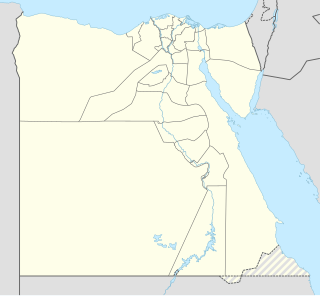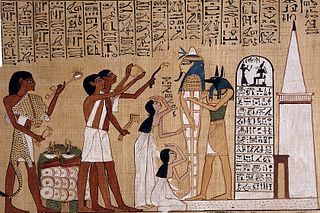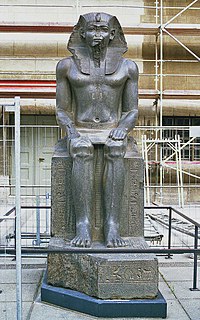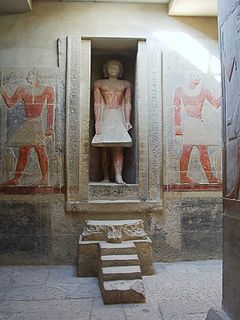
The Book of the Dead is an ancient Egyptian funerary text, used from the beginning of the New Kingdom to around 50 BCE. The original Egyptian name for the text, transliterated rw nw prt m hrw is translated as Book of Coming Forth by Day or Book of Emerging Forth into the Light. "Book" is the closest term to describe the loose collection of texts consisting of a number of magic spells intended to assist a dead person's journey through the Duat, or underworld, and into the afterlife and written by many priests over a period of about 1000 years.

KV55 is a tomb in the Valley of the Kings in Egypt. It was discovered by Edward R. Ayrton in 1907 while he was working in the Valley for Theodore M. Davis. It has long been speculated, as well as much-disputed, that the body found in this tomb was that of the famous Pharaoh Akhenaten, who moved the capital to Akhetaten. The results of genetic and other scientific tests published in February 2010 have confirmed that the person buried there was both the son of Amenhotep III as well as the father of Tutankhamun. Furthermore, the study established that the age of this person at the time of his death was consistent with that of Akhenaten's, thereby making it almost certain that it is Akhenaten's body. However, a growing body of work soon began to appear to dispute the assessment of the age of the mummy and the identification of KV55 as Akhenaten.

The ushabti was a funerary figurine used in ancient Egyptian religion. The Egyptological term is derived from Ancient Egyptian: 𓅱𓈙𓃀𓏏𓏭𓀾wšbtj, which replaced earlier 𓆷𓍯𓃀𓏏𓏭𓀾 šwbtj, perhaps the nisba of 𓈙𓍯𓃀𓆭 šwꜣb "Persea tree".

The ancient Egyptians had an elaborate set of funerary practices that they believed were necessary to ensure their immortality after death. These rituals and protocols included mummifying the body, casting magic spells, and burial with specific grave goods thought to be needed in the Egyptian afterlife.

Amenemhat I, also Amenemhet I and the hellenized form Ammenemes, was the first ruler of the Twelfth Dynasty, the dynasty considered to be the golden-age of the Middle Kingdom of Egypt. He ruled from 1991 BC to 1962 BC.

The Pyramid Texts are the oldest known corpus of ancient Egyptian religious texts dating to the Old Kingdom. Written in Old Egyptian, the pyramid texts were carved onto the subterranean walls and sarcophagi of pyramids at Saqqara from the end of the Fifth Dynasty, and throughout the Sixth Dynasty of the Old Kingdom, and into the Eighth Dynasty of the First Intermediate Period.

Nubkaure Amenemhat II was the third pharaoh of the 12th Dynasty of Ancient Egypt. Although he ruled for at least 35 years, his reign is rather obscure, as well as his family relationships.

Lisht or el-Lisht is an Egyptian village located south of Cairo. It is the site of Middle Kingdom royal and elite burials, including two pyramids built by Amenemhat I and Senusret I. The two main pyramids were surrounded by smaller pyramids of members of the royal family, and many mastaba tombs of high officials and their family members. They were constructed throughout the Twelfth and Thirteenth Dynasties. The site is also known for the tomb of Senebtisi, found undisturbed and from which a set of jewelry has been recovered. The pyramid complex of Senusret I is the best preserved from this period. The coffins in the tomb of Sesenebnef present the earliest versions of the Book of the Dead.

Hor Awibre was an Egyptian pharaoh of the 13th Dynasty reigning from c. 1777 BC until 1775 BC or for a few months, c. 1760 BC or c. 1732 BC, during the Second Intermediate Period. Hor is known primarily thanks to his nearly intact tomb discovered in 1894 and the rare life-size wooden statue of the king's Ka it housed.

Nubkheperre Intef was an Egyptian king of the Seventeenth dynasty of Egypt at Thebes during the Second Intermediate Period, when Egypt was divided by rival dynasties including the Hyksos in Lower Egypt. He is known to be the brother of Sekhemre-Wepmaat Intef—and this king's immediate successor—since he donated Louvre Coffin E3019 for this king's burial which bears an inscription that it was donated for king Sekhemre Wepmaat Intef "as that which his brother, king Antefgives", notes Kim Ryholt. As the German scholar Thomas Schneider writes in the 2006 book Ancient Egyptian Chronology :

The Pyramid of Unas is a smooth-sided pyramid built in the 24th century BC for the Egyptian pharaoh Unas, the ninth and final king of the Fifth Dynasty. It is the smallest Old Kingdom pyramid, but significant due to the discovery of Pyramid Texts, spells for the king's afterlife incised into the walls of its subterranean chambers. Inscribed for the first time in Unas's pyramid, the tradition of funerary texts carried on in the pyramids of subsequent rulers, through to the end of the Old Kingdom, and into the Middle Kingdom through the Coffin Texts which form the basis of the Book of the Dead.
The Greek Magical Papyri is the name given by scholars to a body of papyri from Graeco-Roman Egypt, which each contain a number of magical spells, formulae, hymns, and rituals. The materials in the papyri date from the 100s BC to the 400s AD. The manuscripts came to light through the antiquities trade, from the 1700s onward. One of the best known of these texts is the Mithras Liturgy.

The Ancient Egyptian noble Intefiqer(ỉnỉ-ỉt.f ỉqr) was overseer of the city and Vizier under Amenemhet I and Senusret I during the early 12th Dynasty. He is known from several rock inscriptions in Lower Nubia, showing that he was part of a military mission into this region. He appears in an inscription found at the Red Sea coast and in the so-called Reisner Papyri. Two rock inscriptions in Lower Nubia mention him. They seem to indicate that he was involved in a military campaign into this region. The inscriptions are not dated, but other inscriptions in the region seem to indicate a military campaign in year 29 of Amenemhet I, which corresponds to the 9th year of Senusret I. Intefiqer is also known from a stela found at Wadi el-Hudi, dated to year 20. It reports the bringing of Amethyst.

The Pyramid of Amenemhet I is an Egyptian burial structure built at Lisht by the founder of the Twelfth Dynasty of Egypt, Amenemhet I.

Senebsumai was an Ancient Egyptian official. He dates to the thirteenth dynasty and he held important administrative offices during the reign of Sobekhotep III that began ca. 1760 BC through the reign of Neferhotep I that ended ca. 1730 BC.

Rehuerdjersen was an Ancient Egyptian treasurer who held this office under the 12th Dynasty pharaoh Amenemhat I.

Wahneferhotep was an Ancient Egyptian king's son who lived in the Thirteenth Dynasty, around 1700 BC. Wahneferhotep is only known from a shabti and model coffin found in the mortuary temple of the pyramid of Senusret I at Lisht, and now at the Metropolitan Museum of Art. On both objects he bears the title king's son. His name means Neferhotep endures. Neferhotep might refer to king Neferhotep I, who was one of the most powerful rulers of the Thirteenth Dynasty and some scholars argues that this king is the most likely ruler that is mentioned in the name. However, the pottery found near the model coffins points to a later date, making it more likely that Neferhotep refers to another, later, king with the same name.

Senebtisi was an Ancient Egyptian woman who lived at the end of the 12th Dynasty, around 1800 BC. She is only known from her undisturbed burial found at Lisht.

Ancient Egyptian afterlife beliefs were centered around a variety of complex rituals, that were influenced by many aspects of Egyptian culture. Religion was a major contributor, since it was an important social practice that bound all Egyptians together. For instance, many of the Egyptian gods played roles in guiding the souls of the dead through the afterlife. With the evolution of writing, religious ideals were recorded and quickly spread throughout the Egyptian community. The solidification and commencement of these doctrines were formed in the creation of afterlife texts which illustrated and explained what the dead would needed to know in order to complete the journey safely.
Hedjhotep was a minor ancient Egyptian deity, a god of fabrics and clothes and, to a lesser extent, of weaving and the deceased. Hedjhotep is sometimes described as a goddess rather than a god, holding a wadj-scepter and ankh sign. He possibly originated from the northern part of Middle Egypt.



















